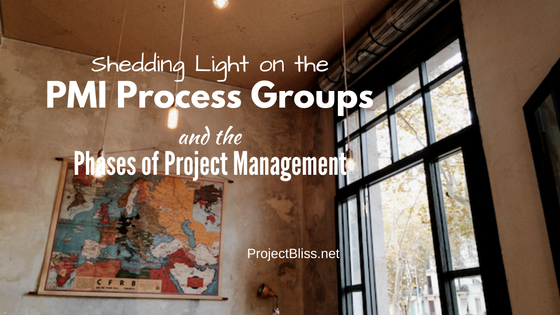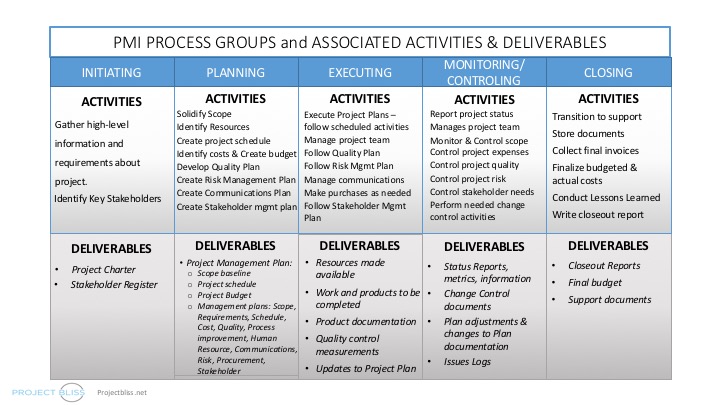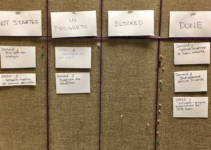I’ve been doing project management for a long time, and have worked in many different types of organizations. The level of project process rigor has varied among them. I’ve discovered that despite where I’ve worked, many of the basics of the PMI process groups apply. This isn’t meant to be a PMI process group study guide (if you’re studying for the PMP). The intent is to provide insight into what is included in each of these PMI process groups. I’ve found them to be helpful and have referred to them even years after getting my PMP certification.
Even if you’re not working toward your certification but simply want to learn more about how to effectively manage projects, understanding what goes into each of the process groups can help you successfully lead projects.
I am writing from an IT perspective, so my examples reflect that, but project management processes and practices are applied across many different disciplines, and I’ll strive to be as generic as possible. Additionally, many individuals may recognize that they are doing much of this currently, even if they don’t go by the title of “Project Manager.”
All PMBOK quotes refer to the 5th edition.
PMI Process Groups – the Project Management Phases
I approach this overview of the PMI Process Groups from the traditional PMBOK perspective (Project Management Body of Knowledge). If you are familiar with PMI’s PMBOK, you’ll know that it lays out the following five project management phases:
- Initiation
- Planning
- Execution
- Monitoring and Controlling
- Closing
In the following project management overview, I’ll cover each of these project management phases and explain the activities and deliverables for each. Each project management phase will have varying durations and levels of work involved depending on the scope and complexity of your project. This can even vary depending on where you work, as different organizations exercise various levels of rigor in their project management practices. In my overview of the PMI process groups, I’ll cover the activities and deliverables for each of the project management phases. Keep in mind that each of these can go much more in-depth. I’ve provided links to more in-depth posts on some of the deliverables where I have the information available. For some reason, each of the project management phases have personalities in my mind. Indulge me. I can’t help it. You likely see these project management phases differently.
Scroll to the bottom to download a 1-Page Quick Reference Guide
PMI Process Groups and Activities
1. Initiating
This is a happy, optimistic phase. There is a new opportunity for delivering a solution, solving a problem, or making an improvement. During the initiation phase, the project manager starts pulling together initial, high-level information, identifies stakeholders, gets a clear idea of the business case, and develops the project charter. PMI’s PMBOK explains the goals of the initiation phase as follows: “the key purpose of this Process Group is to align the stakeholders’ expectations with the project’s purpose, give them visibility about the scope and objectives, show how their participation in the project and its associated phases can ensure that their expectations are achieved.” The primary output is the Project Charter, which contains high-level information about the project. Approval of the Project Charter signifies formal project authorization.
Activities
- Gather high-level information and requirements about the project, such as the following:
- project purpose
- measurable objectives
- high-level requirements
- assumptions / constraints
- project description
- high-level budget
- success criteria
- high-level risks
- project milestones
- project manager
- project sponsor
- project stakeholders
Deliverable
2. Planning
It’s one of the fun PMI process groups, where you plan how you’ll make it happen. Just like planning that big Paris vacation, the planning phase involves pulling together the details of what is needed and nailing down a plan. The team likely has not had many problems, and things still look optimistic. Like before a trip, you need to know who’s doing what and when, how much it will cost, and dependencies. Everyone gets a say because you need input from the team to ensure nothing is missed.
The PMBOK explains that the goal of this process group is “to establish the total scope fo the effort, define and refine the objectives, and develop the course of action required to attain those objectives. There’s a lot that goes into that sentence!
Activities
- Scope: The team determines what will be included as part of the project, and what will not. Sometimes it’s important to be clear about what will be excluded as well, so there’s no question later. Gather more detailed requirements to gain a better understanding of what is involved.
- Work Breakdown Structure (WBS): The project manager works with the team to identify the high-level activities needed to complete the project, and then breaks these out to smaller components. It helps you and the team work through the details of what needs to be done to complete the project
- Schedule: The project manager never creates a schedule without input from those doing the work. Take the input from the WBS and for each task and add durations, dependencies, responsible party, and start and finish dates. Additionally, if you’ll use an outside vendor, you’ll need to consider the need for a request for proposals and contract execution times.
- Cost / Budget: Additionally, this is when you develop the project budget. Get input from everyone on what is needed for the project: hardware, licenses, and anything else you’ll need to purchase. You may need to create a budget for the total cost of ownership (TCO), which includes ongoing support and maintenance for several years out. If you are required to include the cost of employee development time as well, you’ll need to plan for those costs. Again, make sure you check with all team members on what is needed. I have a post on creating the IT Project Budget that is written in the context of an IT project, but some of the guidelines are applicable to other types of projects. I have included a template that can be modified for other types of projects as well.
- Quality: Develop the Quality Management Plan and determine appropriate metrics. Modern quality approaches focus on customer requirements and satisfaction, prevention over inspection, and continuous improvement. There are entire disciplines and organizations focused on quality, such as Six Sigma and the International Organization for Standardization. Don’t overlook this valuable component to your project.
- Human Resources: Plan for project participants by identifying what roles and responsibilities you need for your project. What activities need to be carried out and what areas of expertise are needed. When are these resources needed and are they available?
- Communication Plan: Teams may wish to put together a communication plan to address how information will be shared. If you have virtual teams, plan accordingly. The communication plan will help the team talk through communication needs and ensure that all are aware of communication expectations. By creating the plan, the team will know what information needs to be communicated to whom, and by what channel.
- Risk Plan: The team will identify what potential risks could occur while executing the project, and puts together a mitigation plan for each. This will require input from team members and will help the team plan in advance how to manage each risk should it occur. It will also help the team identify risk triggers to watch for.
- Procurement: Plan for project purchases. This may mean that you need to follow strict processes. If you need to carry out formal requests for proposals and execute any contracts, plan for time for these activities.
- Stakeholders: In addition to the stakeholder identification done during the initiation phase, ensure that all stakeholders are identified, and the team has planned for managing communications and other needs relative to this group.
Deliverables
- Project Management Plan – PMBOK definition: “The document that describes how the project will be executed, monitored, and controlled. It integrates and consolidates all of the subsidiary plans and baselines from the planning processes.”
- This plan contains the following information:
- Scope baseline
- Project schedule
- Project budget
- Additional items listed specifically by PMI (all from PMBOK 5th edition)
- Scope management plan
- Requirements management plan
- Schedule management plan
- Cost management plan
- Quality management plan
- Process improvement plan
- Human resource management plan
- Communications management plan
- Risk management plan
- Procurement management plan
- Stakeholder management plan
The PM and project team may wish to include additional information and are not restricted to the items listed above.
3. Executing
Once you have your plan in place and sign-off to proceed, you can begin executing the plan. I generally start execution with a kickoff meeting, to ensure that the plan is clearly communicated. In case you’re wondering by now, the execution phase is the serious phase. She’s not fooling around. Everyone is getting down to work. I’m not implying that planning isn’t work. There is a great deal of effort that goes into planning! Now it’s time to follow your plan.
PMBOK 5th edition states that this PMI process group “involves coordinating people and resources, managing stakeholder expectations, as well as integrating and performing the activities of the project in accordance with the project management plan.”
In other words, do your plan.
Activities
- PM pulls together the project team: team members are assigned and committed to the project.
- PM develops and manages the team / project: the PM will communicate regularly with the team and ensure that activities are carried out as planned. The PM needs to provide feedback and support for the team, as well as manage conflict and resolve issues. PMBOK 5th edition suggests that “High team performance can be achieved using open and effective communication, creating team building opportunities, developing trust among team members, managing conflicts in a constructive manner, and encouraging collaborative problem solving and decision making.” These are all leadership skills that will be valuable to you as a project manager.
- Resources begin work executing the plan: The resources which have been assigned are now committed and begin following the plan and executing the schedule. The HR management plan plays a role here as well.
- PM performs quality assurance by carrying out the quality management plan. Measure against your determined metrics.
- PM manages communications: PM ensures that scope is adhered to and that all parties are informed, and communications occur as they should, according to the communication plan. There will be communications that are not be captured in the plan through the course of the project. The PM will ensure the creation of necessary documentation related to these communications, such as meeting notes and other necessary artifacts. The PM keeps everyone informed and manages communication needs across team members where needed. This includes stakeholder engagement as well. A great deal of project management relies on communication.
- Purchases are made: The PM can move forward with purchasing items needed and identified during the planning phase. Your organization might also execute vendor contracts during this time.
- Execute the Quality Management Plan. This can be by utilizing tools that your team has identified or processes that your team utilizes, such as Lean Six Sigma processes. If developing software, for example, your team will likely have built various types of testing into the plan.
- Stakeholder Management is carried out by following the communications plan and keeping stakeholders informed of updates and changes. This also includes answering stakeholder questions and hearing and addressing any concerns.
Deliverables
- Resources available and executing the planned work
- Work that is to be produced during execution
- Documents regarding specifications and other product-specific documentation.
- Quality Control Measurements and verified deliverables that meet quality standards
- Updates to the Project Plan
4. Monitoring and Controlling
Monitoring and controlling both happen in parallel with execution. This is the nosey Mrs. Kravitz (Bewitched) – the neighbor who watches and keeps up with everything going on. But with positive intent. The project manager is supporting the team to succeed. The PM and team work together to communicate any changes to the plan. Changes to the plan need to follow any formal change management processes that your organization has in place. This includes scope, schedule, cost and implementing any risk mitigation plans that might be triggered, as well as addressing any risks that were not identified.
Activities
- Status meetings and reporting: During this time the PM and team report on the status of the project, as well as provide any other necessary information. This will vary across organizations, but it is usually required. This will inform stakeholders of the project performance and provide alerts if there are any issues or need for change.
- PM manages the project team. Many of the activities listed above fall under this category as well, such as managing conflicts and problem-solving.
- Monitor and Control the project scope to control scope creep.
- Monitor and track project expenses. Follow organizational processes for any changes to the budget or planned costs.
- Control quality by measuring against metrics identified in the Quality Management Plan and making adjustments as needed.
- Control communications by following the plan and making adjustments as needed. The PM will also need to follow the organization’s standards or guidelines for document retention and recording information. Expert judgment may be needed by those with specific technical expertise. The PM may need to draw on professional judgment when carrying out project communications. In some organizations, information can be sensitive, and the PM needs to act according to the needs of the situation.
- PM manages risk according to the Risk Management Plan: the project manager refers to the risk management plan, and consults with the team regularly to monitor for risk triggers. If any should occur, the project manager follows the plan. If necessary, the project manager should be ready to escalate the risk if needed.
- Control stakeholder relationships and adjust as stakeholder needs arise.
- Perform required change control activities if needed.
Deliverables
- Status Reports, metrics, information
- Change control documentation
- Plan adjustments and Changes to the Project Plan documentation
- Issues Logs
5. Closing
Closing wants to celebrate the successful delivery but is also mindful that there is still work to be done. In the last of the PMI process groups, there are final things to take care of before you can consider the project completely done. It is important to ensure that the final necessary tasks are taking care of.
Activities
- Transition the solution to the support team.
- Ensure users know how to obtain support if needed.
- Ensure all documentation is stored appropriately and the team knows where to find it if needed. Support documentation should be made available to support team.
- Collect final invoices and finalize budgeted v actual costs
- Conduct post-mortem / Lessons Learned
Deliverables
- Closeout reports
- Final budgets
- Support documents and job aids if needed
PMI Process Groups with Activities and Deliverables
Project Management Overview Summary
There’s much more to project management than what I could provide in a high-level overview of these PMI process groups. For example, change management in itself is a huge topic. But by providing this project management overview, I hope I’ve been able to present a good idea of what goes into each of the project management phases.
If you have questions about any of these PMI process groups, I’d love to know.
– If you’re not a project manager, has my project management overview raised your interest in project management?
– Is there more you’d like to know about any of the project management phases?
– If you think of any of the project management phases as your favorite, what are they?
And if you’d like to know more about something, leave a question or use the “contact me” link! I love hearing from readers.
Also, I’ve made a downloadable diagram for the PMI process groups. Click the link below if you’d like me to send it to you. Keep in mind that it’s not meant to substitute for a PMP study guide. You’ll still want to refer to the PMBOK and resources created specifically for that purpose. However, it will serve as a great reference in your project work!










It’s a shame you don’t have a donate button! I’d most certainly donate to this superb blog!
I guess for now i’ll settle for bookmarking and adding your RSS feed to my Google
account. I look forward to brand new updates and will
talk about this blog with my Facebook group. Chat soon!
Thank you. You explained the process groups in a way that makes much more sense then PMBOK. I am a little overwhelmed with the amount of information available. This seems more simple and I like it. I am in a course. Do you mind if I use your chart with the process groups, activities and deliverables for an assignment? I will cite the source and include in references of course.
The Real Person!
Author Leigh Espy acts as a real person and passed all tests against spambots. Anti-Spam by CleanTalk.
I’m so glad it was helpful! PMBOK can be overwhelming!
And yes, thanks for asking – use the chart and please share the article and website with others!
Leigh
Hi just letting you know the link in your above story doesn’t work, it goes to login details for WordPress.
This link is “The Project Charter” early in the story under the header :
DELIVERABLE
The Project Charter
The Real Person!
Author Leigh Espy acts as a real person and passed all tests against spambots. Anti-Spam by CleanTalk.
Natalie,
Thanks for letting me know! I’ve now fixed the link.
I appreciate the help!
Leigh
I really think your PMI Process Groups Slide is great!
The Real Person!
Author Leigh Espy acts as a real person and passed all tests against spambots. Anti-Spam by CleanTalk.
Thanks, Abe! I appreciate it! When I was new to project management and started studying the PMBOK it all felt a bit overwhelming. My goal was to lay it out in a way that is easily consumable.